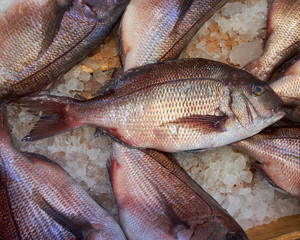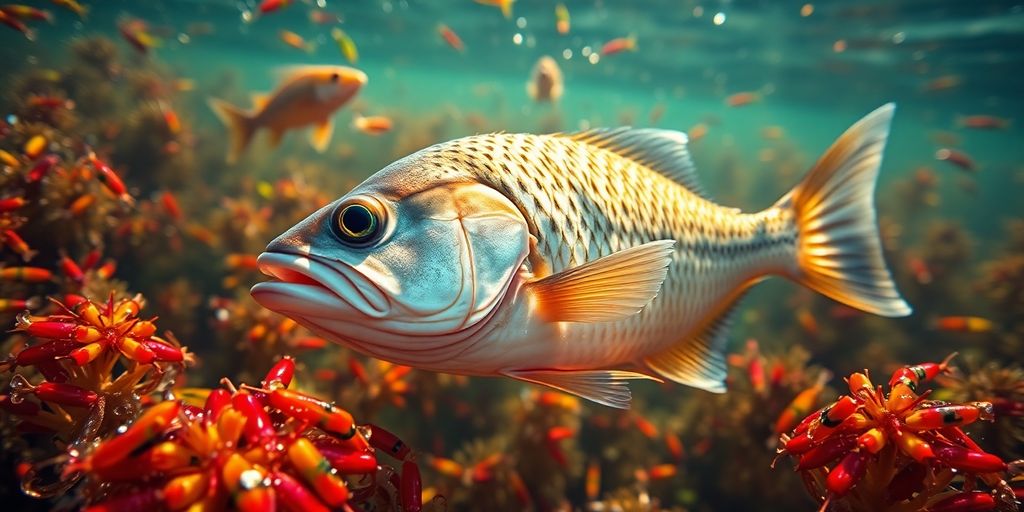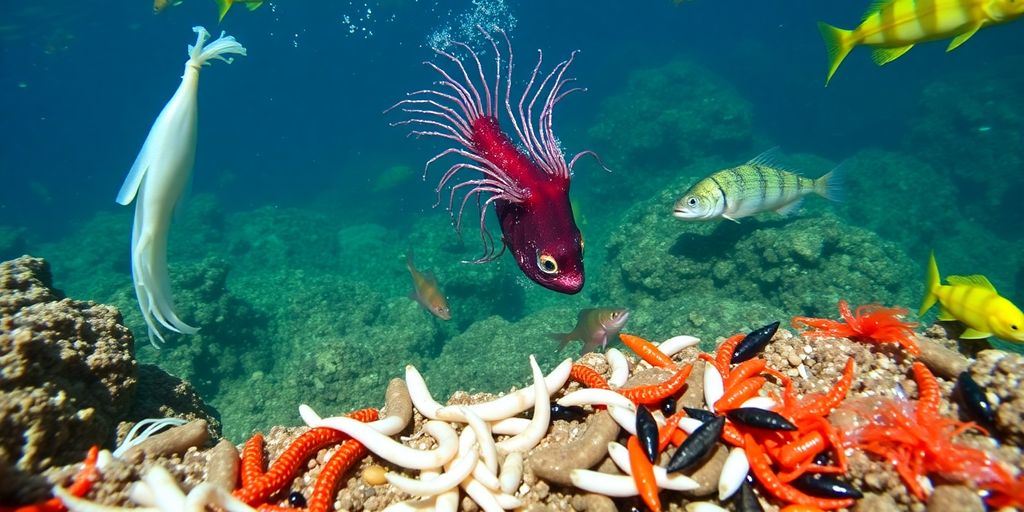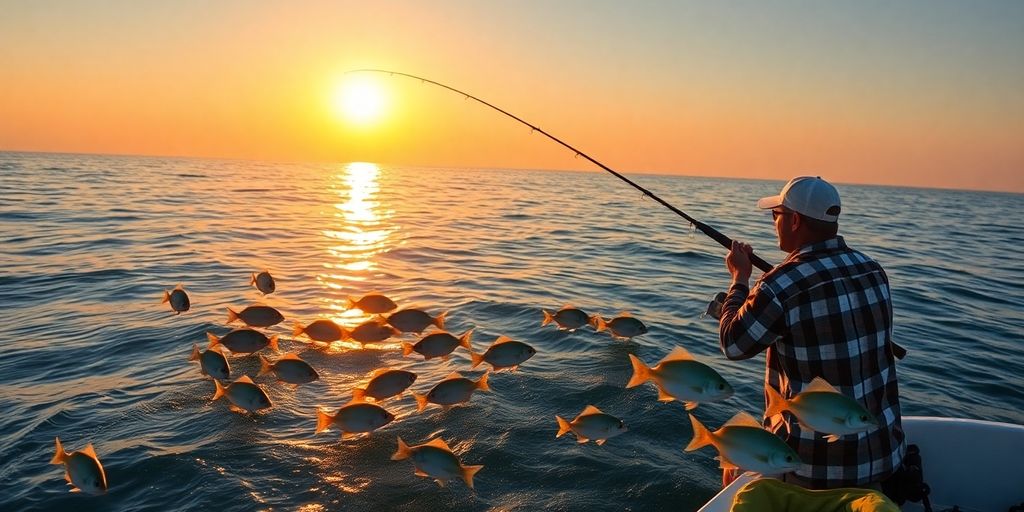Fishing for porgy can be a real treat if you know what you’re doing. These fish are fun to catch and pretty tasty too. But to get the best results, you need to know the right bait and techniques. Whether you’re a seasoned angler or just starting out, understanding porgy behavior and having the right gear can make all the difference. This guide will walk you through everything you need to know, from choosing the best bait for porgy to cooking your catch.

Key Takeaways
- Understand porgy behavior and diet to select the best bait.
- Choose the right gear, including rods, reels, lines, and hooks.
- Master techniques like bottom fishing, chumming, and jigging.
- Use natural baits like clams and squid for better results.
- Follow local regulations to ensure sustainable fishing practices.
Understanding Porgy Behavior and Diet
Feeding Habits and Preferences
Porgies are known for their diverse diet, making them quite the opportunistic feeders. These fish have strong jaws with molar-like teeth, perfect for crunching through hard shells of crabs, clams, and mussels. They also munch on worms, shrimp, smaller fish, and just about anything they can find. Understanding their feeding habits can really boost your fishing game. Porgies tend to feed more actively during daylight, especially in the early mornings and late afternoons.
Impact of Tides on Porgy Activity
Tides play a big role in porgy fishing. Many anglers swear by the incoming tide as the best time to catch these fish. As the water rises, it stirs up the seabed, making food more accessible, which draws porgies in. It’s like a dinner bell for them! Keep an eye on the tide charts before heading out, as timing your trip with the right tide can make all the difference.
Schooling Behavior and Habitat in Shallow Water
Porgies often hang out in schools, especially when they’re younger. This schooling behavior means if you hook one, there are likely more around. They prefer habitats with plenty of cover and food sources, like rocky bottoms, reefs, and wrecks. These spots offer protection and abundant feeding opportunities. If you’re targeting porgies, look for these structures in coastal waters, as they tend to congregate there.
Essential Gear and Tackle for Porgy Fishing

Choosing the Right Rods and Reels for Light Tackle
When it comes to catching porgies, using light tackle can make all the difference. Opt for a light to medium-light rod, typically around 6 to 7 feet long. This size allows for the sensitivity needed to detect those subtle bites. Pair it with a spinning reel in the 2500-4000 size range for a balanced feel. Graphite rods are a great choice here; they offer excellent sensitivity without being too heavy.
Selecting Lines and Leaders
The line you choose is just as important. Braided lines in the 10-20 pound test range are ideal because of their thin diameter, which helps you feel even the slightest nibble. For leaders, go with fluorocarbon in the 15-20 pound range. It’s nearly invisible underwater and can withstand the rough, rocky bottoms where porgies like to hang out.
Importance of Hooks and Rigs
Given that porgies have relatively small mouths, small hooks are essential. Size 1 to 2/0 hooks usually do the trick. Circle hooks are particularly effective because they tend to catch the fish in the corner of the mouth, making it easier to release them unharmed. A hi-low rig, which features at least two hooks above a sinker, is a popular choice for presenting multiple baits at once. Adding small, colorful beads or spinners can also help attract fish, especially in murky waters.
Fishing for porgies is all about having the right gear. From rods and reels to lines and hooks, each piece plays a role in ensuring a successful day out on the water. Make sure your setup is tailored to these bottom-dwellers, and you’ll be well on your way to reeling them in.
Effective Techniques for Catching Porgy

Mastering Bottom Fishing
Bottom fishing is a go-to method if you’re after porgy. You’ll want a medium to light rod and reel setup, something with a sensitive tip to feel those sneaky bites. Keep your bait close to rocky spots, reefs, or shipwrecks—that’s where porgies love to hang out. When you feel a nibble, be quick to set the hook. For bait, you can’t go wrong with clams, squid, or small fish pieces. A two-hook rig with small hooks (think size 4 to 6) can really up your game. Just remember, the sinker weight needs to match the water depth and current. Soft baits like clams and worms are effective but can be easily ripped off the hook by aggressive porgies.
Using Clam Chum to Attract Porgies
Chumming can seriously boost your chances of hooking a porgy. Using a chum pot is a crucial tool for attracting porgies in shallow waters. Clam chum is a favorite for drawing them in. Toss in bits of ground clams or clam juice every now and then to create a chum trail. This works wonders when paired with drift fishing. Let your boat drift over likely spots while keeping your bait near the bottom. Make sure to anchor up-current from where you’re fishing so the chum floats naturally to the fish.
Jigging and Rigging Strategies
Jigging is another solid technique, especially in deeper waters. Small metal or bucktail jigs, around 1/4 to 1 oz, are ideal. Add a little piece of clam or squid to the jig for extra appeal. When it comes to rigging, a high-low rig or dropper loop rig does the trick. These setups let you present multiple baits at different depths. Use fluorocarbon leaders to keep things stealthy in clear water. When jigging, go for a slow, vertical motion. Lift the rod tip 6-12 inches, then let the jig drop. Porgies often hit as the jig falls, so watch for any line movement.
Best Bait Options for Porgy Fishing

Natural Baits: Clams, Squid, and Fish
When it comes to catching porgy, natural baits like fresh clam, squid, and small fish are top contenders. These tasty morsels mimic the porgy’s natural diet, making them irresistible. Fresh clam is particularly effective—its scent can draw porgies from afar and it is also a cost-effective option. Squid, with its tough texture, stays on the hook longer, while small fish like sardines or anchovies can entice larger porgies looking for a meaty meal. Keep your bait pieces small to match the porgy’s mouth size.
Artificial Lures and Jigs
Artificial lures can be just as effective, especially in areas where natural bait is scarce or heavily used. Peanut bunker is an attractive option for anglers targeting porgies. Small jigs, especially those with a bit of flash or color, can attract curious porgies. Bucktail jigs, when tipped with a small piece of bait, can mimic the movement of prey in the water. Soft plastic lures in natural colors are also a good bet, especially when porgies are feeding closer to the surface.
Combining Bait Types for Success
Sometimes, a mix of bait types can be the key to success. Using multiple fish techniques, such as combining natural and artificial baits, can significantly increase your chances of a bite. For instance, try a natural bait on one hook and an artificial lure on another. This method not only diversifies your approach but also lets you see what the porgies are biting on that day. Experimentation is key—what works one day might not work the next, so be ready to switch things up.
Regulations and Sustainability in Porgy Fishing

Understanding Catch Limits and Seasons
Fishing for porgy, or scup, involves adhering to specific regulations designed to keep their populations healthy. Catch limits are crucial to prevent overfishing, ensuring that porgy stocks remain robust for future generations. Typically, recreational anglers face size limits—usually between 9 to 10 inches—and daily bag limits that vary by region. Some areas also implement closed seasons, especially during spawning times, to protect the fish when they’re most vulnerable. It’s important for fishers to stay updated on local rules, as these can change annually based on population assessments.
Complying with Local Fishing Regulations
When heading out to fish, it’s essential to know the local fishing laws. These regulations not only specify size and bag limits but also dictate the types of gear that can be used. For instance, certain areas may require the use of circle hooks to reduce bycatch. Commercial fisheries, on the other hand, often face stricter quotas and gear restrictions to ensure sustainable practices. By following these rules, anglers contribute to the conservation efforts that keep porgy populations thriving.
Sustainable Fishing Practices
Sustainability in fishing isn’t just about following regulations—it’s about adopting practices that support the environment. Using selective gear, like circle hooks, helps minimize the capture of non-target species. Seasonal closures are another strategy, allowing porgy to spawn and replenish their numbers. Additionally, respecting size limits ensures that juvenile fish have the chance to mature. Anglers can also practice ethical fishing by minimizing waste and sharing their catch within the community. These efforts, combined with scientific monitoring of fish stocks, help maintain a balance between human needs and ecological health.
Fishing responsibly means more than just catching fish. It’s about respecting the ocean and its inhabitants, ensuring that future generations can enjoy the thrill of fishing just as much as we do today.
Preparing and Cooking Porgy
Cleaning and Filleting Techniques
Getting your porgy ready for the pan starts with a good cleaning. Unhooking multiple fish when using multiple hooks can be challenging and requires careful handling to avoid tangles. These fish are small and bony, so you’ll need a bit of patience. First, scale it well. You don’t want any of those scales sticking around. Next, make a cut behind the gills and slice down the belly to take out the guts. Rinse it out with cold water to clean up. If you’re filleting, cut down behind the gills to the backbone, then work your knife along the backbone to lift the fillet off. Tweezers can be a lifesaver for picking out any stray bones.
Popular Culinary Uses
Porgy has this mild, sweet taste that works with a lot of dishes. It’s got firm, white flesh that holds up to different cooking styles. Here are some favorites:
- Grilling: Brush a whole porgy with olive oil, sprinkle some herbs, and grill it up.
- Baking: Stuff it with lemon and garlic for a tasty baked dish.
- Pan-frying: Coat fillets in seasoned flour and fry them until crispy.
This fish goes great with light sauces or citrusy dressings. Whether you buy it whole or in fillets, leaving the skin on can add a nice crispy texture when cooking.
Cooking Methods for Optimal Flavor
Cooking porgy isn’t complicated, but getting it right makes all the difference. Grill it, bake it, or fry it—each method brings out different flavors. For grilling, keep it simple with a bit of oil and seasoning. Baking lets you get creative with stuffing and spices. And frying? Well, that’s all about that crispy, golden finish. Remember, cook it to an internal temperature of 145°F to keep it safe and delicious.
Porgy might not be the biggest catch out there, but its flavor and versatility make it a top choice for seafood lovers. Whether you’re a seasoned chef or just starting out, this fish is a rewarding pick for any meal.
Wrapping It Up: Your Porgy Fishing Adventure Awaits
So there you have it, the ultimate guide to snagging those tasty porgies. Whether you’re a newbie or a seasoned angler, these tips and tricks should give you a leg up on your next fishing trip. Remember, it’s all about the right bait, a bit of patience, and maybe a little luck. Don’t forget to check the local rules before you head out, and always respect the ocean and its creatures. Happy fishing, and may your lines be tight and your catches plenty!
Frequently Asked Questions
What kind of bait works best for catching porgy?
Clams, squid, and small pieces of fish are great natural baits for porgy. You can also try using small jigs or lures.
When is the best time to fish for porgy?
Porgies are most active during the day, especially in the early morning and late afternoon. They also tend to bite more when the tide is coming in.
What type of fishing rod should I use for porgy?
A light to medium-light rod, about 6 to 7 feet long, is ideal. It should have a sensitive tip to feel the bites.
How do I clean and prepare porgy for cooking?
Start by scaling the fish, then cut behind the gills and along the belly to remove the insides. You can fillet it by cutting along the backbone and removing any bones.
Are there any fishing rules I need to know about porgy?
Yes, there are usually size and bag limits for porgy. These rules can change, so it’s best to check local regulations before fishing.
Can I use artificial lures to catch porgy?
Yes, small bucktail jigs or soft plastic lures can also be effective for catching porgy, especially when tipped with a bit of bait.



